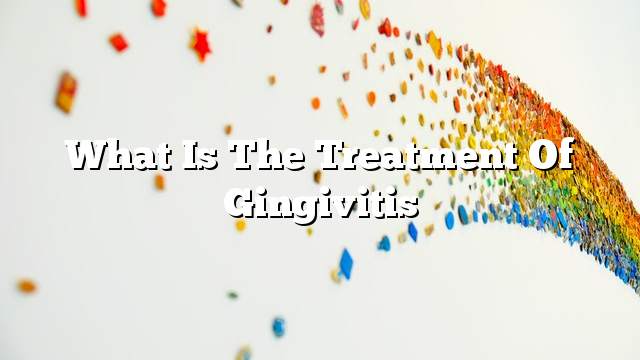Gingivitis
Gingivitis is a common periodontal disease that occurs in the form of redness and bloating in the gums. This is accompanied by bleeding easily when brushing or cleaning teeth. Gingivitis, periodontitis, Gingivitis affects the gums surrounding the teeth, while toothpaste also affects the bone surrounding the teeth, and if neglected treatment of gingivitis, inflammation develops to affect the toothpaste, according to the American Association of Dentistry, gingivitis and inflammation of the teeth are the most important causes of tooth loss End adults, and despite the possibility of the development of gum inflammation to inflammation in periodontal teeth, but this is not necessary to happen.
Treatment of gingivitis
The treatment of gingivitis on the principle of removing all factors that lead to the emergence of inflammation, and can classify the treatment into three main categories as follows:
Cleaning teeth
It is necessary to clean the teeth to remove the layer of plaque and lime that cause irritation of the gums, and it is done in the dental care clinic, and the cleaning of the teeth either using hand tools, or ultrasonic device, or laser, cleaning includes the following operations:
- Calcification of calcareous or calcareous deposits above and below the gums.
- Root planning: In which the contaminated spills are removed on the surface of the root, then it is softened.
- LASER: Laser is less painful to the patient and does not cause excessive bleeding.
Use of medicines
There are a range of medications that are used to treat gingivitis, including:
- Oral preparations containing chlorhexidine, which contain therapeutic properties and have an effect on oral sterilization.
- Antiseptic chips. These chips contain chlorhexidine, which is released from the chip to the gums over time after it is placed inside the gingival pocket after root scrape.
- Antibiotics, used to treat inflamed areas for a long time, are of these doxycycline antibiotics.
Surgical treatment
Gingivitis is sometimes treated by some surgical procedures, including:
- Laparoscopic surgery: In this type of surgery, the gums are lifted surgically so that the limestone can be removed, and the bone edges are removed if they are irregular. This helps to eliminate the places that give the bacteria an opportunity to hide. The gums are then returned to surround the tooth and eliminate the gap between the gums and tooth. This process is also called the pocket reduction surgery.
- Bone grafts and soft tissue grafts: Bone splints are placed from the same person or from a donor. Vaccinations may be artificial bone grafts to compensate for bone loss in areas where gum disease is destroyed. Gingival gums are placed in areas that have a periodontal period or have a periodontal thickness, and gingival buildup is usually taken from the gums that cover the throat’s roof.
Causes of gingivitis
The main cause of gingivitis is the accumulation or formation of the plaque. Balak is a thin layer of bacteria that collects on the surfaces of the teeth, and the accumulation of plaque under the level of the gums to the inflammation, and neglect the removal of plaque leads to hardening component of what is known as teeth, When the inflammation is neglected and left untreated, it causes the gums to separate from the tooth. It may develop into damage to the soft tissue and bone supporting the teeth, leading to age instability, which may lead to tooth loss. Inflammation of the bladder, These factors include:
- Smoking and chewing tobacco, both of which reduce the ability of the gums to heal.
- Places that are difficult to clean and which are a suitable environment for the collection of plaque and lime, and produce these places of irregular arrangement of teeth, ie, oblique teeth and curvature.
- Poor eating habits, such as foods rich in sugars and carbohydrates, and low in water content, which increase the chance of the layer of plaque, and it should be noted that the lack of eating foods rich in vitamin C may delay the healing or prevention of gums.
- Some types of drugs and diseases, including epilepsy drugs such as phenytoin, as well as some angina and high blood pressure medicines, such as calcium channel blockers, as well as certain drugs used in treatment Cancer, and diseases that lead to inflammation of the gums, which are diseases that reduce the immunity of the body such as AIDS and leukemia, and some viral and fungal infections, and cancers ..
- Diabetes, due to impaired diabetes of the blood circulation which reduces the ability of the gums to heal.
- Hormone changes. Hormone changes increase the sensitivity of the gums and make them more susceptible to inflammation, such as during pregnancy, menstrual cycle, puberty, and age of hope. Periodontal disease is 70-90% .
- Tension and anxiety, because of their ability to weaken the immunity of the body.
- Dry mouth, and oral breath.
Prevention of gingivitis
To prevent gingivitis, the following must be followed:
- Brushing the teeth twice a day, and for a better result recommended brushing teeth after each meal, as brushing teeth helps to remove the remnants of food lingering and the layer of plaque also, and it is also advisable to clean the tongue for being a suitable place for the growth of bacteria, It is important to note that the toothbrush needs to be changed every 3-4 months.
- Cleaning between the teeth using a medical dental thread, as the toothbrush can not clean the gaps between the teeth, and advised to use the thread of teeth at least once a day.
- The use of oral lye, as it has the ability to remove remnants of food that still exist even after the use of toothbrushes and dental thread.
- Refrain from chewing tobacco and smoking.
- Perform regular dental cleaning at the dentist’s office.
